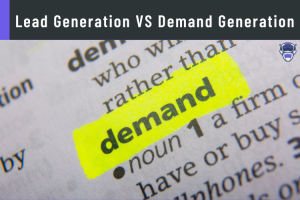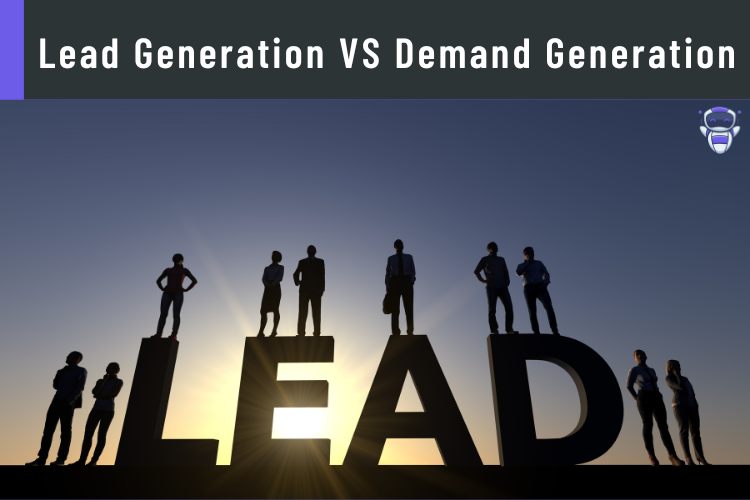There’s some confusion going on between “Lead Generation VS Demand Generation,” people think that both of the terms are the same but it is not. Both of the terms are very different from each other. What confuses people is that both terms are used interchangeably.
Read on to know the distinction between both the terms and how they differ from each other.

Contents
What is Demand Generation?
Demand generation marketing is the process of creating awareness and demand for your products or services. It expands your audience, generates buzz, and drives traffic to transform interest into action.
What is Lead Generation?
Lead generation describes the process of turning prospects who show interest in your product or service into potential customers.
Demand Generation VS Lead Generation:
Demand generation grows your audience by attracting new visitors to your website and introducing them to your solutions. On the other hand, lead generation converts your audience into qualified leads. It’s a subtle distinction, and the two strategies are deeply connected.
Demand gen feeds into lead generation. First, it’s important to drive awareness and develop interest because not everyone is ready to opt-in or convert immediately.
Let’s break down the key difference between lead generation and demand generation:
Demand generation (top of the funnel)
- Increases brand awareness
- Educates your target audience
- Builds trust
- Sparks interest
Lead generation (bottom of the funnel)
- Captures audience contact information
- Generates qualified leads and nurtures them
- Demonstrates brand value and differentiation
- Converts high-quality leads to customers
Demand Generation Tactic:
- SEO-based Content
- Guest Posts
- Trendy Articles
- Offer Free Resources
- Lead scoring
SEO-based Content:
Try to build an effective SEO-friendly webpage as it will help improve your search rankings, bring in more traffic, and create authority with top-of-funnel prospects just beginning the buyer’s journey.
Maintaining first-page rankings in the search for your highest-value keywords takes time and effort, but can establish trust before a prospect even visits your website. All content should be built around your central keyword strategy to maintain high search rankings.
Guest Posts:
Try to look for opportunities where you’re able to showcase your expertise. As a marketer looking to improve their search rankings while simultaneously building authority, a program of guest posting across social media channels can give you more opportunities to get in front of viable prospects, while also demonstrating your expertise in their area of interest.
Building contacts with high-authority sites and posting content to these outlets is effective for link-building to build organic traffic, and can help readers in the awareness stage of the journey begin to know and trust your work more, moving them closer to becoming a lead and later a customer.
Trendy Articles:
For many businesses, trend-spotting and analysis is another important facet of demand generation. Trend-focused pieces operate on a few different fronts. First, they are an excellent means of building authority in an area of expertise.
They demonstrate both your knowledge of the industry and foresight into its potential upcoming changes. Second, much like guest posting, this type of content most often operates by sharing knowledge from industry experts. Write articles on the field of your expertise so that your targeted audiences know that you are sure of what you’re doing.
This will make them have faith in you and your brand leading them to convert into your potential customers.
Offer Free Resources:
One of the easiest ways for prospects to understand the quality of your product or service is to allow them to experience a portion of your offering before they commit to buying. These experiences may include free trials or free-to-use features, audits, estimation tools, calculators, or walkthroughs of simple, self-service tasks.
Once a prospect has tried out your product, he/she will know its usage and importance and they would want to buy from you in the near future.
Lead scoring:
Though not a content-based tactic, lead scoring is a strategy many companies use to make efficient use of their resources based on intent data demonstrated by prospects.
In essence, lead scoring is the process by which marketing “takes the temperature” of a prospect based on what actions they take as a result of your demand generation efforts. For example, if a prospect regularly engages in social media posts or free offers, that may contribute to the lead score.
Once they take action with more intent (for example, signing up for a webinar or downloading a piece of content in return for contact information) this shows marketing that there is sufficient reason to pass the contact along to sales (sometimes called Marketing Qualified Lead or MQL in the pipeline).
Lead Generation Tactics:
- Ebooks, Reports, and Whitepapers
- Direct Mail Marketing
- Webinars
- Live events
- Retargeting Campaigns
Ebooks, Reports, and Whitepapers:
Launch Ebooks, reports, and whitepapers to generate leads. It is a part of gated content, “Gated content” is content that can only be accessed or downloaded after an online visitor (or your prospective customer) comes to your website and gives you some specific information about themselves. This contact information is then, typically, passed on to the sales team to make a connection.
So basically, you can generate contact details through subscriptions to ebooks, reports, and whitepapers.
Direct Mail Marketing:
The lead generation team might use direct mail marketing to forge a stronger relationship. This could take the form of handwritten notes to say thank you for the inquiry, a sweet treat to enjoy during a demo or webinar, or even a personalized gift for a prospect getting close to making a buying decision. Marketers report a 40% response rate when digital and direct marketing are combined.
Webinars:
Capitalizing on the power of personal connection, webinars can be an effective way of forging a stronger relationship during the consideration and decision stages of the funnel, and can even continue to nurture customers once they sign in. Webinars can help with specific parts of the prospect’s pain point, leading to more full-scale assistance in the form of a paid resource, freemium feature, or sign-up. Webinars are a powerful method of generating leads at volume—as many as 500 or 1000 at a time.
Live events:
Host live events and increase your business network. These events allow sales professionals to make human connections with their prospects, answer their questions in a detailed way and personal manner, and even get to know their prospects socially through networking events or booth chats.
When asked about their primary reasons for attending live events, half of the respondents to one study cited lead generation and community-building as prime motivators.
Collect your targeted prospects’ contact information in events like these in order to generate leads for your company.
Retargeting Campaigns:
Retargeting is capitalizing on the attention you’re already getting from a prospect and keeps your brand, product, or resource front and center after they’ve expressed interest in your service by visiting your website.
Through retargeting, prospects not yet ready to commit to a product or service can be served automated touch-points and follow-up offers, nurturing them until the time is right for a call, a demo, or a commitment. Customers that are served retargeted ads are reportedly 70% more likely to convert, making this practice valuable and highly effective.
To Wrap It Up:
However, we’ve already upheld the difference between demand generation vs lead generation and how each of them works. You can use the tactics we’ve shared in this article to apply them to your business.
We hope that this article helped you. Thank you for being and reading with us. Good Luck!
We have more articles on our blog, one such is: “Lead Generation Cost (Everything You Need to Know)” please do have a read!



… [Trackback]
[…] Info to that Topic: blog.leadstal.com/lead-generation-vs-demand-generation/ […]
… [Trackback]
[…] There you can find 33989 additional Info to that Topic: blog.leadstal.com/lead-generation-vs-demand-generation/ […]
… [Trackback]
[…] Information on that Topic: blog.leadstal.com/lead-generation-vs-demand-generation/ […]
… [Trackback]
[…] Information on that Topic: blog.leadstal.com/lead-generation-vs-demand-generation/ […]
… [Trackback]
[…] Find More Information here on that Topic: blog.leadstal.com/lead-generation-vs-demand-generation/ […]
… [Trackback]
[…] Info on that Topic: blog.leadstal.com/lead-generation-vs-demand-generation/ […]
… [Trackback]
[…] Read More on that Topic: blog.leadstal.com/lead-generation-vs-demand-generation/ […]
… [Trackback]
[…] There you will find 94121 additional Information to that Topic: blog.leadstal.com/lead-generation-vs-demand-generation/ […]
… [Trackback]
[…] Find More here on that Topic: blog.leadstal.com/lead-generation-vs-demand-generation/ […]
… [Trackback]
[…] Info to that Topic: blog.leadstal.com/lead-generation-vs-demand-generation/ […]
… [Trackback]
[…] Find More on on that Topic: blog.leadstal.com/lead-generation-vs-demand-generation/ […]
… [Trackback]
[…] Find More Info here to that Topic: blog.leadstal.com/lead-generation-vs-demand-generation/ […]
… [Trackback]
[…] Here you can find 56247 additional Info to that Topic: blog.leadstal.com/lead-generation-vs-demand-generation/ […]
… [Trackback]
[…] Read More on to that Topic: blog.leadstal.com/lead-generation-vs-demand-generation/ […]
… [Trackback]
[…] Here you will find 76908 more Info on that Topic: blog.leadstal.com/lead-generation-vs-demand-generation/ […]
… [Trackback]
[…] Read More Info here to that Topic: blog.leadstal.com/lead-generation-vs-demand-generation/ […]